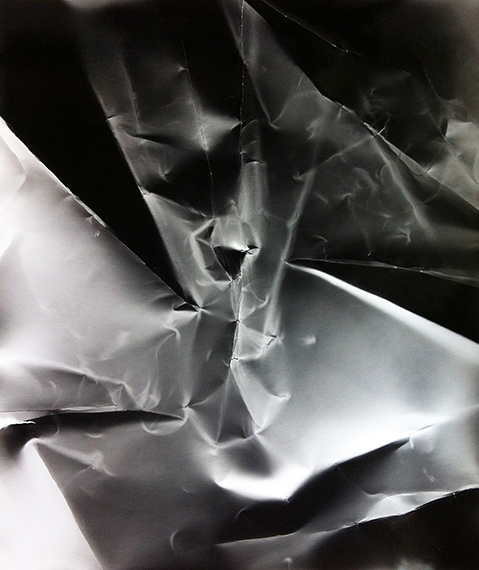
Silver gelatin photogram
61x50.8 cm / 24x20 inches, unique
Black & White, topographies
Photo Days 2024
Ellen Carey » Tomas Van Houtryve »
Exhibition: 31 Oct – 23 Dec 2024
Thu 31 Oct 18:00
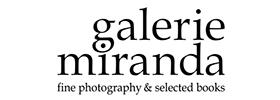
Galerie Miranda
21 rue du Château d’Eau
75010 Paris
+33(0)1-40 38 36 53
enquiries@galeriemiranda.com
www.galeriemiranda.com
Tue-Sat 12-19
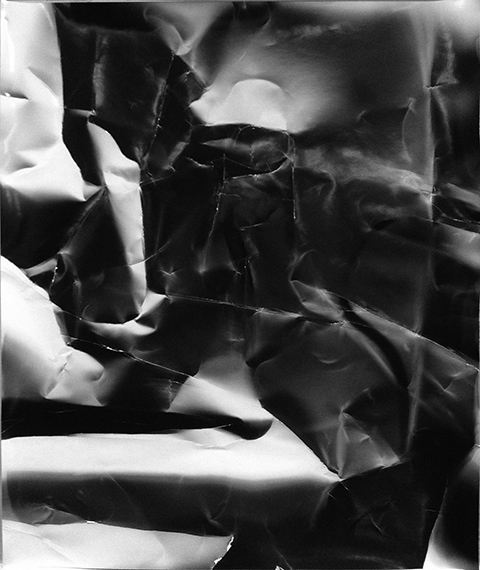
Silver gelatin photogram
61x50.8 cm / 24x20 inches, unique
The third chapter of the gallery collaboration features rare black and white works by Ellen Carey (1952, American) from her early series of darkroom experiments Dings & Shadows and Photogenic Drawing; her abstract, sculptural silver gelatin photograms are presented in dialogue with recent B&W photographs by Tomas Van Houtryve (1975, Belgian-American), of the Notre Dame cathedral in Paris, from his series "Thirty Six Views of Notre Dame", produced in partnership with the EPRNDP (Etablissement public chargé de la conservation et de la restauration de la cathédrale Notre Dame de Paris), French public entity in charge of the cathedral's restoration after the 2019 fire. Van Houtryve's documentary images are made with different techniques, both contemporary and 19th century, echoing Carey's contemporary practice with historical photographic processes.
CAREY, ELLEN (represented by Galerie Miranda)
Born in New York City in 1952, Ellen Carey is a contemporary of the "Pictures Generation" artistic movement and Buffalo’s avant-garde, alongside Cindy Sherman and Robert Longo. Artist – photographer and lens-based artist,university educator, independent scholar and guest curator, she is Associate Professor of Photography at the Hartford Art School - University of Hartford (Connecticut). As a visual artist, Carey disrupts collective histories of art and photography through a practice of abstraction that explores the structure and roots of non-color in monochrome black, white and grey while her color palette mirrors photographic color theory RGB=YMC as a conceptual point-of- departure, adding content to context in photography’s collective short histories in color.
Rather than describe object-subject interrelations, her photographs double play between shadow and light explorations, often seen in her minimalist work in black and white, or through images in an endless kaleidoscopic array of multi- or monochromatic colors.
Ellen Carey’s two solo exhibitions: Light Struck at Fox Talbot Museum in Lacock (England) which paralleled her Struck by Light solo at New Britain Museum of Art (www.nbmaa.org) in Connecticut; both extended for a full year (2023-2024), saw collectively 250,000 visitors. In Paris, her work was presented in two group exhibitions at the Bibliothèque Nationale de France: Épreuves de la Matière (2023-24) and Black & White: an aesthetic of photography (2023-24).
In 2018, Ellen Carey was named by the Royal Photographic Society (RPS) as one of the top 100 women photographers worldwide under their Hundred Heroines platform, now a separate organization (www.hundredheroines.org). Her unique and experimental images have been featured in over 70 solo exhibitions and hundreds of group exhibitions.
Series, Dings & Shadows and Photogenic Drawings from artist’s practice, Struck by Light:
"When I was a child, I drew. Raised Catholic, stained-glass windows brought together light and
colors. Ellen, my name, means bringer of light in Irish, Gaelic and Celtic, thus destiny and fate
brought me to photography" (Eye Prefer Paris 2018 interview excerpt).
Struck by Light is the sui generis name of my artistic practice in photogram since 1988, performed in a darkroom (camera obscura) wherein with color, no light is allowed except during exposure. Photograms’ collective histories are plentiful; as practiced in the 19th century by the first experimenters: William Henry Fox Talbot (1800 – 1877) and his contemporary, the Victorian Anna Atkins (1799 – 1871), recognized as the first practicing woman photographer, first in colour with her cyanotypes. In Paris, Man Ray continued this avant-garde tradition as did many others, such as Moholy-Nagy. Most photograms involve placing an object (leaf/lace) on the surface of a light-sensitive paper, that used the sun for exposure, hence the term ’sun pictures’ in the 19th century. The end result was a ghostly, silhouetted negative image of the object’s outline, its ‘shadow’. Talbot’s negative print was contacted for its positive (1840), making the negative and positive axis and duality the foundation of photography." — Ellen Carey
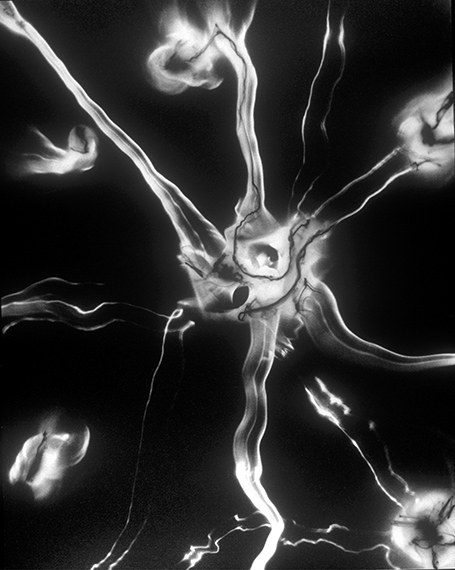
Silver gelatin photogram
50.8x40.6 cm / 20x16 inches, unique
VAN HOUTRYVE, TOMAS (represented par baudoin lebon)
Born in 1975 and of Belgian-American nationality, the artist Tomas van Houtryve initially studied philosophy at the University of Colorado. Known for his mastery of a wide range of photographic techniques, ranging from 19th-century wet collodion on glass plates to augmented reality and aerial drones, his work explores our relationship to identity, memory and power. Tomas van Houtryve's work has been presented around the world, notably at the baudoin lebon Gallery in Paris, the BOZAR Center for Fine Arts in Brussels, the International Center for Photography Museum in New York, the Museum für Fotografie in Berlin, at C/0 Berlin, the British Museum in London, the Fotografisk Center in Copenhagen and the Museum of Contemporary Photography in Chicago. He has also received numerous awards; including the Roger Pic Prize, the CENTER Prize, the CatchLight/Pulitzer Fellowship, the Hasselblad Foundation Prize, the ICP Infinity Prize. Author of several works (Behind the Curtains of 21st Century Communism, 2012; Lines and Lineages Radius Book (2019), Tomas van Houtryve regularly devotes time to education. In partnership with the Pulitzer Center, he works in high schools and universities in California, Colorado, the District of Colombia, Maryland, Missouri, New York, North Carolina, Pennsylvania, Virginia and France.
Represented by the Baudoin Lebon gallery, he has been a member of the VII agency since 2010.
Series Thirty-Six Views of Notre-Dame
Icon, architectural feat, religious sanctuary, subject and muse, Notre-Dame de Paris embodies multiple meanings. Since the invention of photography in 1839, photographers have continued to photograph it, until the dramatic fire of April 15, 2019. Tomas Van Houtryve began photographing Notre-Dame cathedral in 2009, first informally, then as part of a commission to follow the restoration work after the fire of 2019. Choosing to work with a 19th century wooden camera and the wet collodion process, Van Houtryve seeks parallels with the previous restoration of Notre-Dame in the mid-19th century, carried out by the architect Eugène-Emmanuel Viollet-le-Duc. Inspired by the series Thirty-six Views of Mount Fuji by Katsushika Hokusai, Van Houtryve revisits the Parisian icon in unique and unexpected situations. Using a range of old and new techniques - from wet collodion and cyanotype to drone video and artificial intelligence - he questions and reinterprets the visual representation of Notre-Dame.
"Tomas van Houtryve manages to portray the historical, architectural, spiritual, artistic and human greatness that Notre Dame represents."
-----Pauline Vermare, 'Thirty-Six Views of Notre Dame', Radius Books, 2024
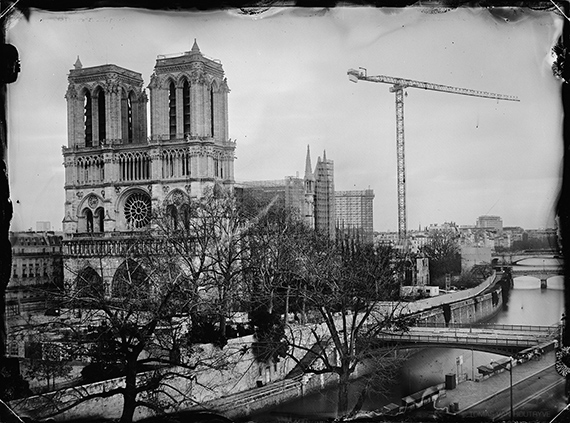
Notre-Dame cathedral without the spire, 2022
Wet collodion print
Courtesy baudoin lebon
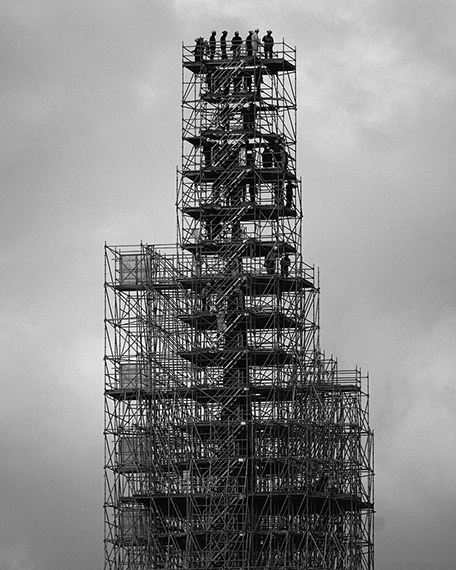
Completion of the new Notre Dame spire, 2023
Wet collodion printv#
Courtesy baudoin lebon